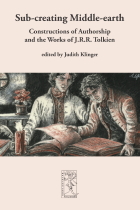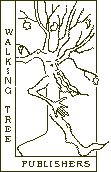Sub-creating Middle-earth – Constructions of Authorship and the Works of J.R.R. Tolkien
Judith Klinger (editor)
Cormarë Series No. 27

<--previous | all publications | next-->
how to buy this item
 Authorship in the works of J.R.R. Tolkien is a subject of many facets.
Within the mythology and history of Middle-earth, many story-tellers,
bards, annalists and poets contribute to the weaving of an enormous
tapestry of tales. Sub-creation, as Tolkien practiced it, involves an
abundance of traditions, including different modes of authorship and
literary creation – and some depart strikingly from the common modern
notions. Instead of proposing a unified perception, the six articles
in this collection therefore examine the web of authorial presence and
authorship concepts in Tolkien's works from diverse angles, to trace a
polyphonous dialogue between the writer of the texts and the many
voices within that shape Middle-earth in concert.
Authorship in the works of J.R.R. Tolkien is a subject of many facets.
Within the mythology and history of Middle-earth, many story-tellers,
bards, annalists and poets contribute to the weaving of an enormous
tapestry of tales. Sub-creation, as Tolkien practiced it, involves an
abundance of traditions, including different modes of authorship and
literary creation – and some depart strikingly from the common modern
notions. Instead of proposing a unified perception, the six articles
in this collection therefore examine the web of authorial presence and
authorship concepts in Tolkien's works from diverse angles, to trace a
polyphonous dialogue between the writer of the texts and the many
voices within that shape Middle-earth in concert.
table of contents | abstracts | announcements | more

Judith Klinger
Introduction
xi
Dirk Vanderbeke & Allan Turner
The One or the Many?
Authorship, Voice and Corpus
1
(abstract)
Martin Simonson
Tolkien's Triple Balance:
A Redemptive Model of Heroism for the Twentieth Century
21
(abstract)
Judith Klinger
Tolkien's 'Strange Powers of the Mind':
Dreams, Visionary History and Authorship
43
(abstract)
Margaret Hiley
(Re)Authoring History:
Tolkien and Postcolonialism
107
(abstract)
Patrick A. Brückner
One Author to Rule Them All
127
(abstract)
Cécile Cristofari
The Chronicle Without an Author:
History, Myth and Narration in Tolkien's Legendarium
173
(abstract)
Index
193

Authorship, Voice and Corpus
A myth, regardless of how many times it is retold and in how many different forms, is ultimately the product of a culture and not of an individual. In the case of a literary creation in the mythical mode, any impression of historical depth must be created by the author, as is well known in the case of Tolkien. We examine Tolkien's technique in comparison with some other re-writers of traditional tales in order to see whether, either inside or outside the fiction, it is possible to establish any real or putative 'original'. We also consider whether the posthumous corpus of texts in the form in which it has been edited by Christopher Tolkien actually equates to the textual structure of a real world mythology, as has been claimed.
A Redemptive Model of Heroism for the Twentieth Century
This paper attempts to disclose Tolkien's authorial presence in The Lord of the Rings by referring to a particular kind of triple balance that is frequently found in the text. The continuous mélange of Christian and pagan elements, together with the story's applicability to twentieth-century themes and concerns, makes the tale articulate an unorthodox and redemptive model of heroism for the contemporary readership which, as we shall see, is closely related to Tolkien's own inner tension.
Tolkien's 'Strange Powers of the Mind':
Dreams, Visionary History and Authorship
Although dreams frequently generate stories, their authors and origins are conceptualized differently within different cultures. While modernity posits the 'unconscious' as the dream's mysterious co-author, pre-modern cultures allow for the intervention of external forces within dreams. Thus dreams hover perpetually on the threshold between different states of awareness and reality. In Tolkien's works, (visionary) dreams and poetry are frequently intertwined as alternative modes of accessing a lost history and Other Time, thereby transcending linear historical narratives. Consequently, the related notions of authorship run counter to the modern concept of identifiable historical origins and point beyond the individual biographical author. My paper examines Tolkien's unique configuration of dream-visions, imagination/invention, and (re-)creative poetry across a range of texts, with a special focus on the correlation of visionary dreams and authorship in The Notion Club Papers and The Lord of the Rings: texts that reforge the tenuous connections between the historical, 'natural' and the mythical, 'supernatural' world. The resulting dialogue between modern and pre-modern epistemologies ultimately defines Tolkien's author-role as it is implied in his texts.
Tolkien and Postcolonialism
The present article begins with the following statement by Tolkien: "I cordially dislike allegory [...] I much prefer history, true or feigned, with its varied applicability to the thought and experience of readers." This quote becomes the point of departure for a discussion of in how far Tolkien's Lord of the Rings can be read as an example of such a 'feigned history', and to which ends concrete historical fragments are incorporated in the work itself. Focusing not just on how Anglo-Saxon fragments are used by Tolkien, but also on why they are used reveals a link to post-Empire resurgent English nationalism and places Tolkien's works within a postcolonial context. By using Old English texts and culture in his works, Tolkien is creating a version of Englishness that effectively writes the Norman Conquest and England's subsequent status as a Norman colony of sorts out of England's history. Running through this discussion of postcolonialism is the question of what model of authorship is necessary for this rewriting of history to become possible. Drawing on Nietzsche's statement that "history is the silent work of the dramatist", we can see that by the time Tolkien was writing, history was not simply the domain of historiographers, but also of authors of fiction; any type of history is, to a certain extent, 'feigned'. This is the position that many postcolonial writers take when dealing with their countries' fraught histories, and it is also the position that becomes evident in Tolkien's case in this postcolonial reading of his work.
Contemporary writing on Tolkien – especially in the aftermath of Tom Shippey's J.R.R. Tolkien: Author of the Century – often focuses on the perceived 'modernity' of his texts. Yet before the 'author' Tolkien can be employed to access his oeuvre, the author has to be constructed by drawing on Tolkien's biography. This author figure then functions to explain (or explain away) apparent anachronisms and incoherencies that scholars routinely encounter in Tolkien's writings. The key words 'Catholicism', 'post-war-writer', 'trauma' and 'coming-of-age-novel' figure prominently in biographically oriented readings of his works (especially of the The Lord of the Rings). The essay shows that constructing Tolkien as a modern author – and, consequently, reading The Lord of the Rings as a modern text – generates additional problems with anachronisms instead of solving them. I therefore aim to counter the most common critical strategy in current Tolkien research. Instead of harmonising textual incoherencies, by focusing exclusively on the 'author' Tolkien, my argument hinges on the alterity of Tolkien's oeuvre and discusses The Lord of the Rings as an exemplary work. Based on Tolkien's own reasoning in On Fairy-Stories, it can be demonstrated that the frequently cited medieval sources should not be read as underwriting a notion of original authorship but as an instance of the writer's commitment to epic traditions.
The Chronicle Without an Author:
History, Myth and Narration in Tolkien's Legendarium
In the cycle constituted by The Silmarillion, The Lord of the Rings, and The Children of Húrin, Tolkien's secondary world is represented from a historical perspective. Yet Tolkien did not mean to write a pastiche of a modern history book. His works rather appear as a compilation of documents from various sources, reminiscent of mediaeval narratives of history. However, some of these documents should not have existed, since, according to the text itself, they deal with events that were either never reported, or never written about. The author(s) of the chronicle of Middle-earth remains elusive; there appears to be no mediation between events and legends, facts and their narration. Historical events and written history develop together in a symbiotic growth, paradoxically achieving a great impression of reality: The text points to its own gaps where there could always be more stories, and no definitive interpretation is suggested. Tolkien thus achieves his ideal of fantasy: not simply a narrative, but a secondary creation, as real in its own way as the primary world.

Book reviews in Inklings-Jahrbuch (28th June 2014)
New publication – Sub-creating Middle-earth (20th November 2012)
Upcoming publications (30th January 2012)

209 pages, Walking Tree Publishers 2012, Cormarë Series No. 27, Editor: Judith Klinger
, ISBN: 978-3-905703-27-6.

<--previous | all publications | next-->
how to buy this item

More on Sub-creating Middle-earth – Constructions of Authorship and the Works of J.R.R. Tolkien

terms and conditions
visitors since 12.11.12
last updated 12.11.12
